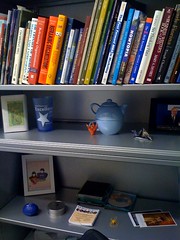Julie Edwards and I were interviewed by Christopher Kenneally for a Velosity of Content podcast episode entitled, "Making Libraries Welcoming Spaces." The 24-minute episode is available on the VOC website and wherever you get your podcasts. A transcript is also available.
Julie and I are both librarians, who interact with the profession in many different ways. However, what has brought us together is our work with Widerstand Consulting, where we are involved in anti-racism work. Julie, who is White, and I are part of a multiracial team for Widerstand. We bring our knowledge, passion, and patience to the work of helping organizations understand how to become more anti-racist. Becoming anti-racist is not something a person or organization does overnight, rather it can be a winding path that takes more time and intention that one might desire. And it is a path that can include both moving forward and moving backward, because"fumbles" will occur.
Why are libraries working on becoming anti-racist? As Julie said in the interview, "There is a real interest in making libraries more welcoming to students
and deconstructing some of these structures that have been set in place
that aren’t serving the students or the librarians anymore." We could not mention in 24 minutes all of the areas which libraries are tackling, so we didn't get into collection development or how materials in a library are catalogued. However, both of those areas need to change to become more inclusive, less governed by White ideals, and more open to all those who need to use them. Yes, so many areas that need focus from staff hiring, to development of library services, to marketing, to....everything!
Below is a 2-minute video preview to the 24-minute audio episode. Yes, do listen to the entire episode. If it raises questions, please post them as questions here (as comments) or reach out to me. If your curious about Widerstand, you can find information about them on their website.
Addendum (8/22, 10:45 a.m.): The digital journal, University Business, has published an article, How to create a campus library that welcomes everyone by Christopher Kenneally, which is related to the podcast.
